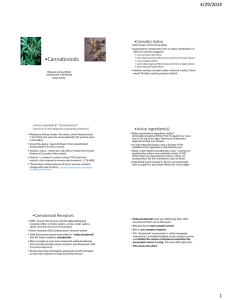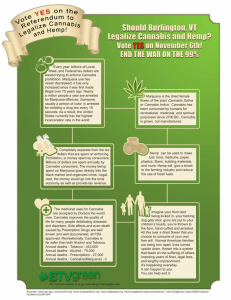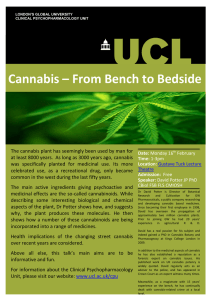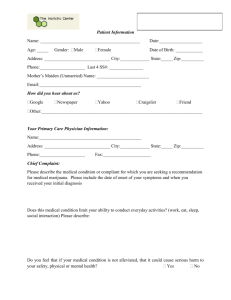CME_071715_Blinderman_HOs - St. Charles Health System
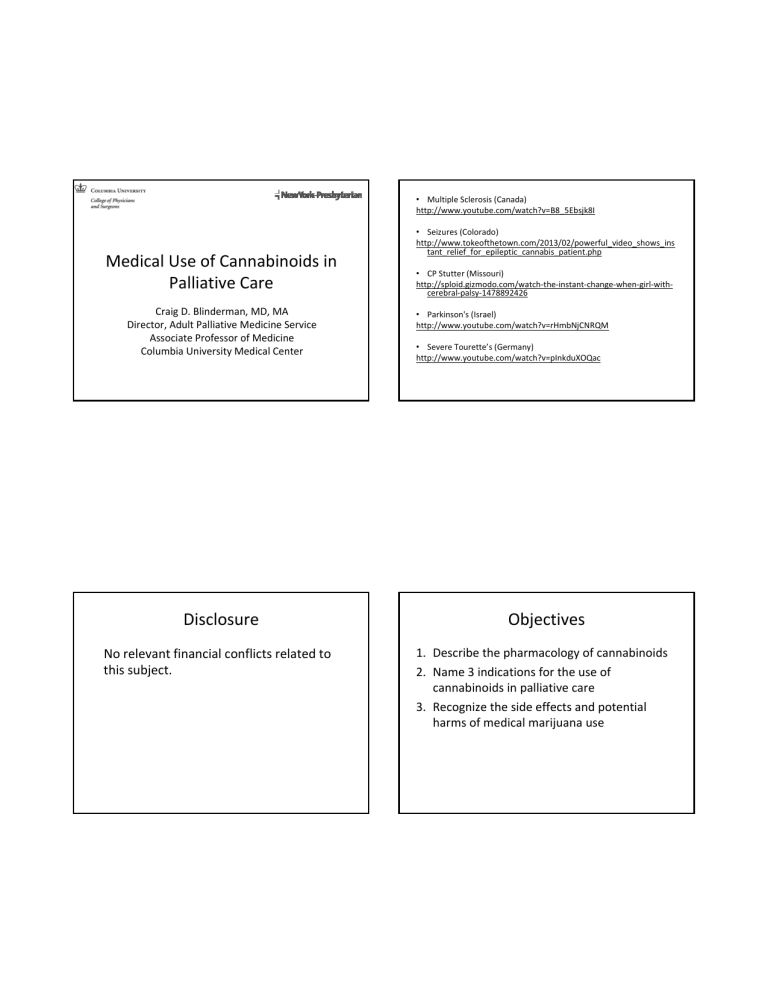
Medical
Use
of
Cannabinoids
in
Palliative
Care
Craig D.
Blinderman, MD, MA
Director, Adult Palliative Medicine Service
Associate Professor of Medicine
Columbia University Medical Center
• Multiple Sclerosis (Canada) http://www.youtube.com/watch?v=B8_5Ebsjk8I
• Seizures (Colorado) http://www.tokeofthetown.com/2013/02/powerful_video_shows_ins tant_relief_for_epileptic_cannabis_patient.php
• CP Stutter (Missouri) http://sploid.gizmodo.com/watch ‐ the ‐ instant ‐ change ‐ when ‐ girl ‐ with ‐ cerebral ‐ palsy ‐ 1478892426
• Parkinson's (Israel) http://www.youtube.com/watch?v=rHmbNjCNRQM
• Severe Tourette’s (Germany) http://www.youtube.com/watch?v=pInkduXOQac
Disclosure
No
relevant
financial
conflicts
related
to
this
subject.
Objectives
1. Describe the pharmacology of cannabinoids
2. Name 3 indications for the use of cannabinoids in palliative care
3. Recognize the side effects and potential harms of medical marijuana use
Outline
• Background of cannabinoids
– History
– Pharmacology
• Medical Use in Palliative Care
– Cannabis
– Synthetic cannabinoids
• Side Effects and Safety Concerns
• Legal and Ethical Issues
Background
A
SHORT
HISTORY
OF
CANNABINOIDS
Cannabinoids and Opioids:
An Historical Perspective
First evidence of medicinal use in China
3000 BC
Cannabinoids
W.B.
O’Shaughnessey’s work popularizes cannabis use
1800’s
Medicinal cannabis use declines
1900’s
9 ‐ THC identified as main psychoactive agent in
Cannabis sativa plant
1964
1988: CB
1 receptor identified.
1990: CB
1 receptor cloned
1992: Anandamide discovered, CB2 receptor identified
1993: CB2 receptor cloned
1998: Endogenous cannabinoid ligands shown to be analgesic
1988 1998
500 BC
Earliest known reference for opium ‐ based elixir
1522
Paracelsus reference to
“laudanum”, opium ‐ based elixir, as a potent painkiller
1804 1817
1804: Morphine extracted from opium poppy plant
1817: Morphine first marketed in Germany as analgesic
1874 1900’s
Morphine
1874:
(heroin)
1900s:
analogs synthesized: oxycodone,
codeine, dihydromorphine, pethidine, oxymorphone
Diacetylmorphine
Opioids
1970 1975
1970s: Discovery of opioid receptors –
µ (mu), к (kappa), δ (delta)
1975: Discovery of endogenous opioid peptides ‐ endorphins
Slide courtesy of M.
Ware 1. Mack A & Joy
2. Notcutt
J.,
W.,
2001.
2004.
Notable
history
of
cannabis
• Shen Nung , an emperor of China (also the discoverer of tea and ephedrine), is held to be among the first to report on therapeutic uses of cannabis in a medicinal compendium that dates to 2737 BCE.
• In 1839, William O’Shaughnessy , a British doctor working in India, published a paper on cannabis as an analgesic and appetite stimulant that also tempered nausea, relaxed muscles, and might ameliorate epileptic seizures.
– Led to widespread medical use of cannabis in the United
Kingdom (E.g.
it was prescribed to Queen Victoria for relief of menstrual discomfort)
Groopman, J.
NYRB , 2014.
Legal
prohibition
of
cannabis
for
medical
use
in
the
U.S.
• 1937: Harry J.
Anslinger, a prominent prohibitionist, successfully lobbied Congress to pass the Marihuana Tax
Act, making access to the plant costly.
– Anslinger was the head of the Federal Bureau of Narcotics and presented cannabis use to the public as an unalloyed danger, resulting in “reefer madness.”
– The AMA opposed the Marihuana Tax Act, fearing that it would limit medicinal study and potential prescription of the plant.
• 1942: Marijuana was removed from the United States
Pharmacopeia , a compendium that set standards for medicines and foods.
• 1970: Congress enacted the Controlled Substances Act, classifying marijuana along with heroin as a Schedule I drug.
Groopman, J.
NYRB , 2014.
Today: States that have legalized cannabis for medical purposes
Background
PHARMACOLOGY
Overview
of
Cannabinoid
Pharmacology
• Cannabis strains may vary by morphology, odor, and chemotype, producing plant resin with varying ratios of pharmacologically active cannabinoids, principally tetrahydrocannabinol (THC) and cannabidiol (CBD) , terpenoids, flavonoids, and other molecules.
• Although other receptors play a role, the majority of the effects of
THC from cannabis are mediated through partial agonism of central and peripheral cannabinoid receptors, CB1 and CB2 , respectively.
• Activation of CB1 and CB2 directly inhibits the release of multiple neurotransmitters including acetylcholine, dopamine, and glutamate while indirectly affecting γ‐ aminobutyric acid, N ‐ methyl ‐
D ‐ aspartate, opioid, and serotonin receptors.
Russo EB.
Br J Pharmacol.
2011; 163:1344 ‐ 64.
Wilson RI, Nicoll RA.
Nature.
2001; 410:588 ‐ 592.
Aggarwal SK.
Clin J Pain.
2013; 29(2):162 ‐ 171.
Davison SN, et al.
J Pain Symptom Manage.
2011; 41(4):768 ‐ 78
Overview
of
Cannabinoid
Pharmacology
• Cannabinoid receptors (CB1, CB2) are part of the endocannabinoid system (ECS), a pro ‐ homeostatic modulatory system composed of several endogenous ligands (e.g.
anandamide and 2 ‐ arachidonylglycerol)
• Physiologically, the ECS been shown to impact pain perception, movement, appetite, aversive memory extinction, hypothalamic ‐ pituitary ‐ adrenal (stress) axis modulation, immune function, mood, inflammation, and others.
Russo EB.
Br J Pharmacol.
2011; 163:1344 ‐ 64.
Wilson RI, Nicoll RA.
Nature.
2001; 410:588 ‐ 592.
Aggarwal SK.
Clin J Pain.
2013; 29(2):162 ‐ 171.
Davison SN, et al.
J Pain Symptom Manage.
2011; 41(4):768 ‐ 78
Cannabinoid Receptors
CB1
Receptor
Activation
Cannabinoid binding (activation) negatively coupled to adenylate cyclase, suppresses neuronal Ca 2+ conductance, inhibits inward rectifying K + conductance suppression of neuronal excitability
Cannabinoid
receptors
are
found
in
the
pain
neural
matrix
CB1
• Periaqueductal gray
• Rostral ventromedial medulla (nucleus raphe magnus ‐‐ antinociceptive actions of cannabinoids within RVM are primarily due to presynaptic inhibition of GABAergic neurotransmission)
• Thalamus
• Dorsal root ganglion
• Amygdala
• Cortex
CB2
• Immune cells, including microglia – cytokine, chemokine modulation
• Dorsal root ganglion
• Brainstem
• Thalamus
• Periaqueductal gray
• Cerebellum
Regulation
of
nausea
and
vomiting
by
the
endocannabinoid
system
• CB1 receptors are found in the dorsal vagal complex
(medullary nucleus solitarius, area postrema, dorsal motor nucleus of the vagus).
• CB1 receptor agonists reduce in intestinal 5 ‐ HT release, suggesting enterochromaffin cells express functional CB1 receptors.
• Cannabinoid inhibition of 5 ‐ HT3 receptor activity in this region—increased GABAergic activity
• Receptor ‐ independent pathways too
Sharkey KA, et al. European Journal of Pharmacology . 2014;722:134-146.
Martin BR and Wiley JL. Mechanism of Action of Cannabinoids: How It May Lead to Treatment of Cachexia, Emesis, and
Pain. Journal of Supportive Oncology. 2004;2(4):305-316.
Pacher P, Batkai S, Kunos G. The Endocannabinoid System as an Emerging Target of Pharmacotherapy. Pharmacological
Reviews . 2006;58(3):389-462.
1.
Cannabinoids induce cancer cell death
2.
Cannabinoids inhibit angiogenesis, invasion and metastasis
Anti
cancer
properties?
Velasco G, et al.
The use of cannabinoids as anticancer agents.
Prog Neuro ‐
Psychopharmacol Biol Psychiatry (2015) http://dx.doi.org/10.1016/j.pnpbp.2015.05.010
Pharmacokinetics
• 95 ‐ 99% THC is plasma protein bound (lipoproteins)
• Metabolism via hydroxylation, oxidation, and conjugation (CYP2C9 and
CYP3A)
– First ‐ pass metabolism with oral admin.
(11 ‐ OH ‐ THC)
• Rapidly cleared from plasma (70% tissues / 30% metabolized)
• Elimination over several days (adipose)
• THC is excreted via both hepatic and renal mechanisms.
• No specific studies have been done with cannabis ‐ based medicines in patients with significant hepatic or renal impairment, but it can be expected that effects would be more exaggerated or prolonged in these settings.
• Breastmilk distribution
• Pregnancy Category C
• Excretion: days to weeks
– 20 ‐ 35% found in urine
– 65 ‐ 80% found in feces
– 5% as unchanged drug (when given PO)
MEDICAL CANNABIS
SYMPTOM
MANAGEMENT
IN
PALLIATIVE
CARE
The
evidence
• Over the last several decades cannabis and cannabinoid therapeutics have been studied in over 100 controlled clinical trials of varying size and quality, investigating a wide range of conditions.
• As with the evidence for most pharmacologic symptom interventions, there are a lack of comparative data between cannabis and other commonly used treatments.
Hazekamp A, Grotenhermen F: Review on clinical studies with cannabis and cannabinoids 2005–2009.
Cannabinoids 2010;5:1–21
Hill KP et al.
JAMA 2015;313(24):2474 ‐ 2483) Slide courtesy of Sunil Aggarwal, MD
• Total: 24,023 ‐‐ 2.3
publications/day for last 20 years
• 2013 projected: 280 in first 38 days Æ 2689.
Cancer
Pain
• For cancer pain , a multicenter RCT, involving
360 patients, investigated oral cannabis to treat breakthrough cancer pain in subjects who were started on a long ‐ acting opioid.
• It showed analgesic efficacy in the low and medium dose ranges, which were also well ‐ tolerated.
Portenoy RK, et al.
Nabiximols for opioid ‐ treated cancer patients with poorly ‐ controlled chronic pain: a randomized, placebo ‐ controlled, graded ‐ dose trial.
J Pain.
2012;
13(5):438 ‐ 449.
Painful
Neuropathy
• Two RCTs of inhaled cannabis for painful HIV sensory neuropathy involving 89 subjects in total showed significant analgesic efficacy,with a combined NNT of 3.38, superior to all other medications similarly tested for this indication.
Abrams DI, et al.: Cannabis in painful HIV ‐ associated sensory neuropathy.
Neurology 2007;
68:515–521.
Ellis RJ, et al.: Smoked medicinal cannabis for neuropathic pain in HIV: A randomized, crossover clinical trial.
Neuropsychopharmacology 2009;34:672–680.
Phillip TJ, et al.: Pharmacological treatment of painful HIV ‐ associated sensory neuropathy: A systematic review and meta ‐ analysis of randomised controlled trials.
PLoS One 2010;5:e14433.
Chronic,
intractable
neuropathic
pain
• Three RCTs of inhaled cannabis for chronic, intractable neuropathic pain due to multiple etiologies, involving 100 subjects in total, all showed efficacy for smoked and vaporized cannabis.
Wilsey B, et al.: A randomized, placebo ‐ controlled cross ‐ over trial of cannabis cigarettes in neuropathic pain.
J Pain 2008;9:506–521.
Ware MA, et al.: Smoked cannabis for chronic neuropathic pain: A randomized controlled trial.
CMAJ 2010;182: E694–E701.
Wilsey B, et al.: Low ‐ dose vaporized cannabis significantly improves neuropathic pain. J Pain
2013;14:136–148.
Nausea
and
Vomiting
• Three RCTs, involving 43 subjects in total, investigating inhaled cannabis for nausea and vomiting secondary to active cancer chemotherapy, demonstrated inhaled cannabis to be an efficacious antiemetic.
Chang AE, et al.
Ann Intern Med 1979;91:819–824.
Chang AE, et al.
Cancer 1981;47: 1746–1751.
Levitt M, et al.
Proc Am Soc Clin Oncol 1984;3:91(abstr C ‐ 354).
Appetite
Stimulation
for
Anorexia
• Three RCTs of inhaled cannabis involving 107 subjects in total congruently showed efficacy for appetite stimulation and weight gain in patients with AIDS wasting syndromes.
• No studies have reported a benefit in cancer patients.
Abrams DI, et al.: Short ‐ term effects of cannabinoids in patients with HIV ‐ 1 infection.
Ann Intern
Med 2003;139:258–266.
Haney M, et al.: Dronabinol and marijuana in HIV+ marijuana smokers: Acute effects on caloric intake and mood.
Psychopharmacology 2005;181:170–178.
Haney M, et al.: Dronabinol and marijuana in HIV ‐ positive marijuana smokers.
J Acquir Immune Defic
Syndr 2007;45: 545–554.
Spasticity
in
Multiple
Sclerosis
Spasticity (both objective and subjectively assessed), spasm frequency, insomnia, pain, and impaired mobility—were shown to be significantly improved in a 630 subject multicenter RCT over a 12 ‐ month period.
Zajicek J, et al.: Cannabinoids in multiple sclerosis (CAMS) study: Safety and efficacy data for 12 months follow up.
J Neurol Neurosurg Psychiatry 2005;76:1664–1669.
Prescribing
medical
marijuana
• Exact dosages depend on individual patient need and tolerance of side effects.
No evidence based guidelines on dosing have been developed.
• Cannabis preparations include:
– resin ‐ containing herbal flowers, which can be heated and delivered to the lungs via inhalation of smoke or vapor,
– cannabis ‐ based extracts, which include oral, oromucosal, rectal, and topically delivered preparations in the form of concentrates, suppositories, edibles, and salves .
Aggarwal S, Blinderman CD.
Fast Facts #279 JPM, 2014
FDA ‐ Regulated Cannabinoid ‐ Based Medicines:
Chemicals, Extracts, Botanicals
Photo from epocrates.com
Dronabinol
(Marinol™)
Nabilone
(Cesamet™ )
Photo from nida.org
Cannabis Sativa L.
Extracts (Sativex™)
Photo from Russo et al.
2002
Cannabis Sativa L.
Cigarettes
1985 1985
Photo from wikipedia.org
2006
Photo from Russo et al.
2002
Approximately 460 chemical constituents, >100 phytocannabinoids
1976
From: Medical Marijuana for Treatment of Chronic Pain and Other Medical and Psychiatric Problems: A Clinical
Review
JAMA. 2015;313(24):2474-2483. doi:10.1001/jama.2015.6199
Date of download: 6/29/2015
Copyright © 2015 American Medical
Association. All rights reserved.
Prescribing
medical
marijuana
• Cannabinoids are lipophilic and have nearly immediate onset of action when smoked or vaporized.
• Vaporization has the advantage of rapid onset of effect and easy dose titration.
– Patients can be advised to pause briefly between inhalations to ascertain effectiveness of the medicine and to stop when maximum effect is achieved.
• Oral ingestion of cannabis products has a delayed onset of action compared to inhalation and titration is more difficult.
• Maximum cannabinoid blood levels are reached up to six hours post oral ingestion, with a half ‐ life of 20 to 30 hours.
Aggarwal S, Blinderman CD.
Fast Facts #279 JPM, 2014
SYNTHETIC CANNABINOIDS (DRONABINOL AND NABILONE)
SYMPTOM
MANAGEMENT
IN
PALLIATIVE
CARE
Nausea
and
Vomiting
• Dronabinol and nabilone are FDA approved for the treatment of nausea and vomiting associated with cancer chemotherapy in patients who have failed to respond to conventional antiemetics.
• There are no published studies comparing dronabinol and nabilone to newer antiemetic agents.
Arnold RM, Wilner LS.
Fast Facts #93 Cannabinoids In The Treatment Of
Symptoms In Cancer And Aids
Orexigenic
(appetite
stimulation)
• Only dronabinol is FDA approved for the treatment of anorexia associated with weight loss in patients with HIV/AIDS.
– Early studies of dronabinol in this population showed promising increases in caloric intake and stabilization or gains in weight.
– However, later analysis showed that the effect sometimes represented accumulation of water or fat instead of the preferred lean body mass.
• Neither dronabinol or nabilone are indicated for cancer associated anorexia.
Arnold RM, Wilner LS.
Fast Facts #93 Cannabinoids In The Treatment of
Symptoms In Cancer and AIDs.
Dosing
synthetic
cannabinoids
• Dronabinol (Marinol)
– Chemotherapy induced N/V: 5mg/m 2 PO 1 ‐ 3 hours before and Q2 ‐ 4 hr after chemo; may be increased in 2.5mg/m 2 increments to 15mg/m 2 ; not to exceed 4 ‐ 6 doses/day
– Appetite stimulation: 2.5mg
PO Q12hr, may be increased to 20mg/day
• Nabilone (Cesamet)
– Chemotherapy induced N/V: 1 ‐ 2mg PO Q8 ‐ 12h
MEDICAL CANNABIS AND CANNABINOIDS
SAFETY
AND
PUBLIC
HEALTH
CONCERNS
Safety
and
Public
Health
Concerns
Safety:
• Occasional and low cumulative marijuana use was not associated with adverse effects on pulmonary function (Pletcher MJ, et al.
JAMA 2012)
• Medical cannabis laws (from 1999 ‐ 2010) are associated with significantly lower opioid overdose mortality rates.
(Bachhuber MA, et al.
2014)
• Unlike opioid overdose, marijuana toxicity is not fatal.
Concerns:
• Marijuana adverse effects—acute and chronic (Volkow ND, et al.
NEJM , 2014)
• Increased risk of MVA’s with acute marijuana impairment (Hartman
RL, Huestis MA.
Clin Chem , 2013)
• Preliminary research points to an association between marijuana use and MI, stroke, and PVD (Thomas G,et al..
Am J Cardiol .
2014)
Adverse Effects of Short ‐ Term Use and Long ‐
Term or Heavy Use of Marijuana.
Effects of short ‐ term use
• Impaired short term memory
• Impaired motor coordination, interfering with driving skills and risk of injuries
• Altered judgment, increasing risk of sexual behaviors, transmission of STDs
• High doses: paranoia and psychosis
Effects of long ‐ term or heavy use
• Addiction
– ~9% of users overall, 17% of those who begin use in adolescence, and
25 ‐ 50% of daily users
• Altered brain development
• Poor educational outcome, increased likelihood of dropping out of school
• Cognitive impairment
• Diminished life satisfaction and achievement
• Symptoms of chronic bronchitis
• Increased risk of chronic psychosis disorders in persons with predisposition
Volkow ND et al.
N Engl J Med 2014;370:2219 ‐ 2227.
Level of Confidence in the Evidence for Adverse Effects of Marijuana on Health and
Well ‐ Being.
Volkow ND et al.
N Engl J Med 2014;370:2219 ‐ 2227.
Increases over Time in the Potency of Tetrahydrocannabinol (THC) in Marijuana and the
Number of Emergency Department Visits Involving Marijuana, Cocaine, or Heroin.
Synthetic
Cannabinoids:
“Legal
Alternative
to
Marijuana”
Volkow ND et al.
N Engl J Med 2014;370:2219 ‐ 2227.
Clusters of Cases of
Adverse Health Effects or
Severe Toxic Effects and
Deaths Associated with
Synthetic Cannabinoid
(SC) Product Use.
Trecki J et al.
N Engl J Med
2015;373:103 ‐ 107.
Integrating medical marijuana in clinical practice
LEGAL
AND
ETHICAL
ISSUES
Legal
and
Ethical
Issues
• Federal law vs state law
– Annas, G.
NEJM , 2014
• Protection to discuss marijuana as part of doctor ‐ patient confidentiality
– Protected under federal law even in states where it is illegal to prescribe
• Conflict of interest
– Should physicians who serve as “scientific advisors” to marijuana growers/suppliers be allowed to prescribe?
Take Home Points
• Cannabinoids act on unique G ‐ protein receptors (CB1 and
CB2) found in the CNS, immune system, and elsewhere in the body.
• High quality studies have demonstrated that cannabinoids can be of benefit in patients with cancer pain, neuropathic pain, anorexia, nausea/vomiting, and spasticity.
• There are no evidence ‐ based dosing guidelines for inhaled or ingested cannabis.
• Side effects (short and long term) may be significant and should be reviewed with patients in whom cannabinoids are being considered.
Questions?

